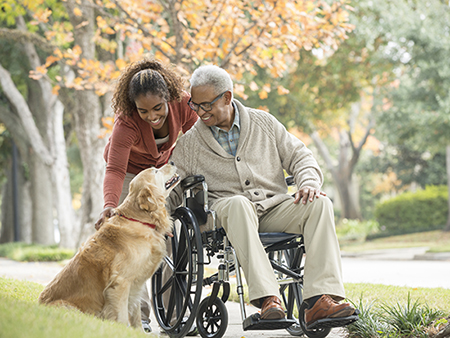 A team of UAB researchers found even a small influence from AAT dogs is meaningful and valuable to someone after a life-changing spinal cord injury.Every year, approximately 17,000 new cases of spinal cord injury are reported in the United States. Recovering from an SCI can take a huge mental, emotional and physical toll on patients, but animal-assisted therapy may play an integral role in easing some of the challenges patients face.
A team of UAB researchers found even a small influence from AAT dogs is meaningful and valuable to someone after a life-changing spinal cord injury.Every year, approximately 17,000 new cases of spinal cord injury are reported in the United States. Recovering from an SCI can take a huge mental, emotional and physical toll on patients, but animal-assisted therapy may play an integral role in easing some of the challenges patients face.
Researchers at the University of Alabama at Birmingham have partnered with Hand in Paw, Alabama’s premier animal-assisted therapy provider, to assess the efficacy of AAT dogs as an aid in rehabilitation following an SCI.
“The average hospital stay for a patient with traumatic SCI is more than 35 days, a span that is emotionally and physically demanding on patients,” said David Schwebel, Ph.D., associate dean for Research in the UAB College of Arts and Sciences. “Patients often experience significant pain as they rehabilitate from their injury and cope with the reality of lifelong disability. Because of this, SCI patients are at a high risk for psychological distress, including depression and anxiety.”
Due to the risk of psychological distress, rehabilitation is central to an SCI patient’s care management plan and can help with both physical and emotional health. However, little is known about how to help patients cope with the physical and psychological effects of this therapy on people with a traumatic SCI.
The study examined at the effects of AAT on mood, outlook, pain and stress in people undergoing occupational therapy during rehabilitation from traumatic SCIs. Thirty-one patients with an SCI were evaluated over four sessions of occupational therapy. Beforehand and afterward, they evaluated their positive and negative emotions and completed a pain survey, and also had the cortisol levels in their saliva sampled to measure biological levels of stress.
AAT dogs interacted with some of the patients for those four rehabilitation sessions, which were managed through trained occupational therapists. Patients were asked to interact with the dogs in ways that promoted mobility and range of motion, including reaching for, petting or walking with the dogs to assist with core strength. Fine motor skills were encouraged by pulling treats from bags, feeding dogs, pouring water for dogs from bottles, placing clips in the dogs’ hair and draping necklaces over the dogs’ necks.
 David Schwebel, Ph.D.The study found that stress levels decreased for participants in the AAT group, and saw modest reductions in participating patients’ pain and unpleasantness ratings following therapy sessions. These results show that AAT may have a positive effect on the perception of pain during occupational therapy rehabilitation sessions.
David Schwebel, Ph.D.The study found that stress levels decreased for participants in the AAT group, and saw modest reductions in participating patients’ pain and unpleasantness ratings following therapy sessions. These results show that AAT may have a positive effect on the perception of pain during occupational therapy rehabilitation sessions.
AAT was most effective for patients in their first session, especially in improving negative mood or low enthusiasm. Schwebel hopes future research will explore the possibility that a single session of AAT may be enough to achieve significant benefits for patients. This finding would mean AAT resources could be used more broadly with more patients, instead of using limited resources for several sessions with fewer patients, he says.
“We found that having therapy dogs present offered a little bit of help during recovery,” Schwebel said. “Our influence was small, but even a small influence is meaningful and valuable to someone after a life-changing spinal cord injury. Dogs soothe us when we are down and comfort us when we are in pain, and our results suggest they even help us after a life-changing injury. More research is needed; but we encourage Hand in Paw and similar agencies to continue their valuable work, as it seems to offer health benefits to patients.”
The research team includes Schwebel; Sarah J. Adkins from the UAB Department of Biology; Maggie Leopard, Cameron Spencer, Lauren Bolden, Christina H. Jagielski from the UAB Department of Psychology; David Bentley from the UAB Department of Psychology; Elizabeth Richardson from the UAB Department of Physical Medicine and Rehabilitation; Adam M. Goodman from the UAB Department of Neurology; and lead author Andie Thompkins from animal-assisted therapy organization Hand in Paw.